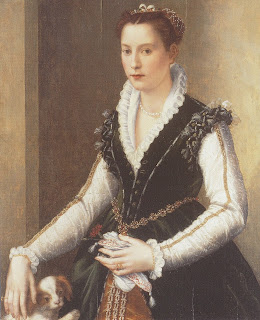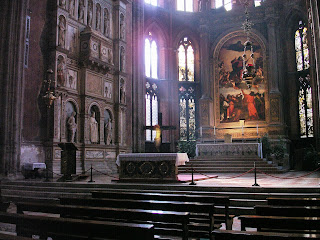The shocking fate of a Spanish noblewoman
 |
| Leonora, as depicted by the 16th century portrait painter Alessandro Allori |
The murder was carried out by her husband, Pietro, but he
was never brought to justice. His brother, Francesco, the Grand Duke of
Tuscany, gave out as the official line that his sister-in-law had died as a
result of an accident.
Eleonora, who was more often referred to as Leonora, was
born in Florence in 1553, the daughter of Garcia Alvarez di Toledo and Vittoria
d’Ascanio Colonna. Her father and mother were living in Florence at the time
because Garcia was in charge of the castles of Valdichiano.
When her mother died a few months later, the baby, Leonora,
was left in the care of her aunt, Eleonora, the Duchess of Florence, and her
husband, the Grand Duke Cosimo I de' Medici, who raised her, preparing her for
a life at the Medici court.
After the Duchess, Eleonora, died, her daughter, Isabella,
took over the supervision of the young Leonora.
A marriage was arranged between Leonora and Cosimo’s son and
Isabella’s brother, Pietro, with the approval of King Philip II of Spain.
 |
| Alessandro Allori's portrait of what is thought to be Pietro de' Medici |
Isabella chose not to live at her husband’s castle, or in
Rome, where Orsini conducted his political and amorous affairs, but remained in
Florence at her own villa, cultivating an artistic salon and discreetly taking
lovers.
Leonora was part of Isabella’s circle and followed her
example in sponsoring the arts and charities and also in taking lovers.
Under Cosimo I de' Medici such behaviour was tolerated as
long as discretion was maintained. But when he died and was succeeded by his
son, Francesco, things changed. Although he had a mistress himself, Francesco
was less tolerant than his father. Crucially, he was less willing to turn a
blind eye to the behaviour of Isabella and Leonora and to ignore the complaints
of their husbands.
However, neither woman realised the danger posed to them by
the new regime.
On 11 July 1576 Pietro sent a note to his brother, the Grand
Duke Francesco, saying that Leonora had died as the result of an accident.
 |
| Isabella suffered the same fate as Leonora |
But, in fact, Leonora’s death at the age of 23 was not an
accident. She had been strangled by her own husband.
Six days later, Isabella was also strangled by her husband
at a remote villa in Cerreto Guidi in Tuscany.
Word soon got out in Florence that both women had been
murdered in cold blood by their husbands.
The Spanish were outraged at the treatment of Leonora and
eventually Francesco admitted the truth to Philip II of Spain, on whose favour
his title depended.
Pietro was never brought to justice for Leonora’s murder,
despite the protests of her brother, Pedro Alvarez de Toledo y Colonna. Pietro
was eventually exiled by Francesco and died in 1604, heavily in debt because of
his gambling.
The Villa Medicea di Caffagiolo, where Leonora was
strangled, is near the Tuscan town of Barberino di Mugello, 25 kilometres north
of Florence. The villa was reconstructed following the designs of the
Renaissance architect Michelozzo in the 1450s and became a meeting place for
many Renaissance intellectuals. Pietro had summoned his wife to the villa and
strangled her with a dog leash after letters from Leonora’s lover had fallen
into the hands of the Grand Duke, Francesco.
Travel tip:
Cerreto Guidi, where Isabella was strangled in a remote
villa, is about 30 kilometres west of Florence. The Grand Duke, Francesco,
announced that his sister’s death was an accident. The 16th century Medici
villa is in the centre of the village. It is claimed that the ghost of Isabella
still roams the villa seeking peace. The legend attracts many visitors who want
to see the bedroom where the murder took place.




